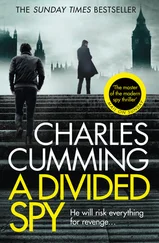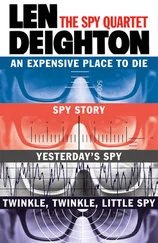Ben Macintyre - A Spy Among Friends
Здесь есть возможность читать онлайн «Ben Macintyre - A Spy Among Friends» весь текст электронной книги совершенно бесплатно (целиком полную версию без сокращений). В некоторых случаях можно слушать аудио, скачать через торрент в формате fb2 и присутствует краткое содержание. Год выпуска: 2014, ISBN: 2014, Издательство: Bloomsbury Publishing, Жанр: Старинная литература, на английском языке. Описание произведения, (предисловие) а так же отзывы посетителей доступны на портале библиотеки ЛибКат.
- Название:A Spy Among Friends
- Автор:
- Издательство:Bloomsbury Publishing
- Жанр:
- Год:2014
- ISBN:9781408851746
- Рейтинг книги:5 / 5. Голосов: 1
-
Избранное:Добавить в избранное
- Отзывы:
-
Ваша оценка:
- 100
- 1
- 2
- 3
- 4
- 5
A Spy Among Friends: краткое содержание, описание и аннотация
Предлагаем к чтению аннотацию, описание, краткое содержание или предисловие (зависит от того, что написал сам автор книги «A Spy Among Friends»). Если вы не нашли необходимую информацию о книге — напишите в комментариях, мы постараемся отыскать её.
A Spy Among Friends — читать онлайн бесплатно полную книгу (весь текст) целиком
Ниже представлен текст книги, разбитый по страницам. Система сохранения места последней прочитанной страницы, позволяет с удобством читать онлайн бесплатно книгу «A Spy Among Friends», без необходимости каждый раз заново искать на чём Вы остановились. Поставьте закладку, и сможете в любой момент перейти на страницу, на которой закончили чтение.
Интервал:
Закладка:
The admiration of his subordinates was echoed by the approbation of Philby’s superiors. Felix Cowgill called him ‘a good cricket umpire’. There could be no higher praise. Here was a man who played by the most honourable rules. But some saw a flicker of something else in Philby, something harder and deeper, a ‘calculating ambition’, a ruthless ‘single-mindedness’. Like Elliott, he used humour to deflect inquiry. ‘There was something mysterious about him,’ wrote Trevor-Roper. ‘He never engaged you in serious conversation – it was always irony.’
As head of the Iberian section, Philby faced a formidable challenge. Although Spain and Portugal were officially neutral non-combatants in the war, in reality both countries tolerated, and even actively encouraged, German espionage on a grand scale. Wilhelm Leissner, the Abwehr chief in Spain, presided over a well-funded, sprawling intelligence network made up of more than 200 officers (more than half the German diplomatic presence) with some 1,500 agents deployed around the country. Leissner’s principal target was Britain: recruiting and despatching spies to the UK, bugging the British embassy, bribing Spanish officials and sabotaging British shipping. Portugal was another hotbed of espionage, although Abwehr operations were less efficient under the command of a dissolute German aristocrat named Ludovico von Karsthoff. The Abwehr poured spies and cash into Spain and Portugal, but in his duel with Leissner and Karsthoff Philby had one overwhelming advantage: Bletchley Park, the top-secret decoding station where intercepted German wireless messages were decrypted, furnishing a priceless insight into Nazi intelligence. ‘It was not long before we had a very full picture of the Abwehr in the Peninsula,’ wrote Philby. That information would soon be put ‘to good use in disrupting, or at least seriously embarrassing, the enemy on his own chosen ground’.
Nicholas Elliott’s task of attacking German intelligence in the Netherlands, his former stamping ground, was a different proposition, and even harder. The Abwehr in Nazi-occupied Holland was highly effective, recruiting, training and despatching a stream of spies to Britain. By contrast, infiltrating agents into Holland was exceptionally difficult. The few networks that had survived the Venlo incident were riddled with Nazi informers.
In a plot that smacks of James Bond (and has all the hallmarks of an Elliott ruse) a Dutch agent named Peter Tazelaar was put ashore near the seafront casino at Scheveningen, wearing full evening dress covered with a rubber suit to keep him dry. Once ashore, Tazelaar peeled off his outer suit and began to ‘mingle with the crowd on the front’ in his dinner jacket, which had been sprinkled with brandy to reinforce the ‘party-goer’s image’. Formally dressed and alcoholically perfumed, Tazelaar successfully made it past the German guards, and picked up a radio previously dropped by parachute. The echo of 007 may not be coincidental: among the young blades of British intelligence at this time was a young officer in the Naval Intelligence Department named Ian Fleming, the future author of the James Bond books. Ian Fleming and Nicholas Elliott had both experienced the trauma of being educated at Durnford School; they became close friends.
Peter Tazelaar was one of the few to make it back to Britain. Of the fifteen agents sent into Holland between June 1940 and December 1941, only four survived, thanks to the brutal efficiency of Major Hermann Giskes, the head of Abwehr counter-intelligence in Holland, Elliott’s opposite number. In August 1941, Giskes intercepted a team of Dutch SOE agents shipped into Holland by fast torpedo boat and forced them, under threat of execution, to send encrypted wireless messages back to Britain, luring more spies across the water. Some fifty-five Dutch agents were subsequently captured and dozens executed, in a Double Cross operation codenamed Englandspiel (‘The England Game’), before two managed to escape and alert the British to the fact that they were being hoaxed. Winding up the operation, Giskes sent a final, mocking wireless message: ‘This is the last time you are trying to make business in Netherlands without our assistance Stop we think this rather unfair in view our long and successful co-operation as your sole agents Stop but never mind whenever you will come to pay a visit to the Continent you may be assured that you will be received with the same care and result as all those who you sent us before Stop so long.’ The episode was, in Philby’s words, ‘an operational disaster’, but almost equally alarming was the discovery that German intelligence in Holland had managed to slip at least one spy into Britain undetected.
In the spring of 1941, the body of a Dutchman was found in an air raid shelter in Cambridge. His name, unimprovably, was Engelbertus Fukken. In his pockets and suitcase were found a Dutch passport, a forged identity card, and one shilling and sixpence. He had parachuted into Buckinghamshire five months earlier, passed himself off as a refugee and shot himself in the head when he ran out of money. No Nazi spy had managed to remain at large for so long, and there was no trace of him in the Bletchley Park intercepts, which raised, for Elliott, the worrying possibility that there might be others at large.
Under Cowgill’s relaxed regime, the officers of Section V could visit London ‘virtually at will’. Philby and Elliott seized every opportunity to do so, in order to cultivate ‘contacts with other SIS sections, with MI5 and with other government departments’, while also visiting their clubs and, in the summer, watching the cricket together at Lord’s. Both volunteered for ‘fire-watching nights’, once or twice a month, at MI6 headquarters, monitoring the telegrams that came in overnight from around the world, which offered a fascinating insight into British intelligence operations. Within the secret brethren, Elliott and Philby were the closest of siblings, revelling in the shared risks, hard work and ribaldry.
One morning in 1941, Kim Philby caught the train to London, taking with him, as usual, a ‘bulging briefcase and a long visiting list’. He also carried a detailed description of the workings of Section V, its personnel, aims, operations, failures and successes, written out in ‘longhand, in neat, tiny writing’. After completing his round of meetings at MI5 and MI6, Philby did not head to the bar beneath MI6, nor to his club; nor to the Harris home for an evening of drinking and secret-sharing. Instead he descended into the St James’s Park Underground station. He let the first train leave without boarding. Then he waited until every other passenger had boarded the next train, before slipping on just as the doors closed. Two stops later, he alighted and caught a train in the opposite direction. Then he hopped on a moving bus. Finally certain that he was not being followed (‘dry-cleaned’, in spy jargon), Philby made his way to a park, where a stocky, fair-haired man was waiting for him on a bench. They shook hands; Philby handed over the contents of his briefcase, and then headed to King’s Cross to catch the train home to St Albans.
Had Nick Elliott examined the report about Section V written by his best friend, he would have been amazed, and then mortified. One passage read: ‘MR NICHOLAS ELLIOTT. 24, 5ft 9in. Brown hair, prominent lips, black glasses, ugly and rather pig-like to look at. Good brain, good sense of humour. Likes a drink but was recently very ill and now, as a consequence, drinks little. He is in charge of Holland . . .’
Elliott would have been still more astonished to discover that the man hurrying away into the night with the bundle of papers was an officer of the NKVD, Stalin’s intelligence agency, and that his friend Kim Philby was an experienced Soviet spy of eight years’ standing, codenamed ‘Sonny’.
Читать дальшеИнтервал:
Закладка:
Похожие книги на «A Spy Among Friends»
Представляем Вашему вниманию похожие книги на «A Spy Among Friends» списком для выбора. Мы отобрали схожую по названию и смыслу литературу в надежде предоставить читателям больше вариантов отыскать новые, интересные, ещё непрочитанные произведения.
Обсуждение, отзывы о книге «A Spy Among Friends» и просто собственные мнения читателей. Оставьте ваши комментарии, напишите, что Вы думаете о произведении, его смысле или главных героях. Укажите что конкретно понравилось, а что нет, и почему Вы так считаете.












